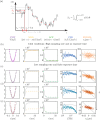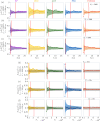Optimal calibration of optical tweezers with arbitrary integration time and sampling frequencies: a general framework [Invited]
- PMID: 38420310
- PMCID: PMC10898575
- DOI: 10.1364/BOE.495468
Optimal calibration of optical tweezers with arbitrary integration time and sampling frequencies: a general framework [Invited]
Abstract
Optical tweezers (OT) have become an essential technique in several fields of physics, chemistry, and biology as precise micromanipulation tools and microscopic force transducers. Quantitative measurements require the accurate calibration of the trap stiffness of the optical trap and the diffusion constant of the optically trapped particle. This is typically done by statistical estimators constructed from the position signal of the particle, which is recorded by a digital camera or a quadrant photodiode. The finite integration time and sampling frequency of the detector need to be properly taken into account. Here, we present a general approach based on the joint probability density function of the sampled trajectory that corrects exactly the biases due to the detector's finite integration time and limited sampling frequency, providing theoretical formulas for the most widely employed calibration methods: equipartition, mean squared displacement, autocorrelation, power spectral density, and force reconstruction via maximum-likelihood-estimator analysis (FORMA). Our results, tested with experiments and Monte Carlo simulations, will permit users of OT to confidently estimate the trap stiffness and diffusion constant, extending their use to a broader set of experimental conditions.
© 2023 Optica Publishing Group.
Conflict of interest statement
The authors declare no conflicts of interest.
Figures





References
-
- Jones P. H., Maragó O. M., Volpe G., Optical Tweezers: Principles and Applications (Cambridge University Press, 2015).
-
- Gieseler J., Gomez-Solano J. R., Magazzù A., Castillo I. P., García L. P., Gironella-Torrent M., Viader-Godoy X., Ritort F., Pesce G., Arzola A. V., Volke-Sepúlveda K., Volpe G., “Optical tweezers — from calibration to applications: a tutorial,” Adv. Opt. Photonics 13(1), 74–241 (2021).10.1364/AOP.394888 - DOI
-
- Volpe G., Marago O. M., Rubinsztein-Dunlop H., et al. , “Roadmap for optical tweezers 2023,” JPhys Photonics 5(2), 022501 (2023).10.1088/2515-7647/acb57b - DOI
-
- Zemánek P., Volpe G., Jonáš A., Brzobohatỳ O., “Perspective on light-induced transport of particles: from optical forces to phoretic motion,” Adv. Opt. Photonics 11(3), 577–678 (2019).10.1364/AOP.11.000577 - DOI
LinkOut - more resources
Full Text Sources
